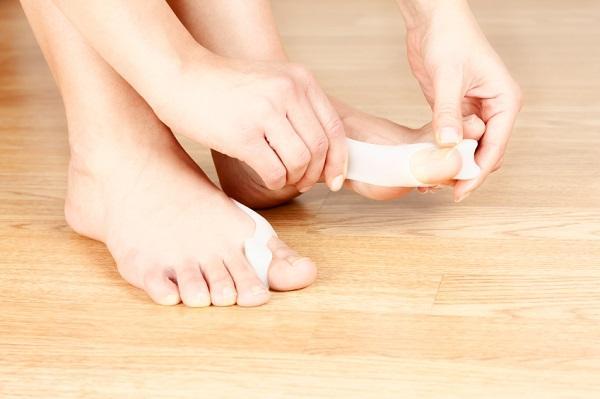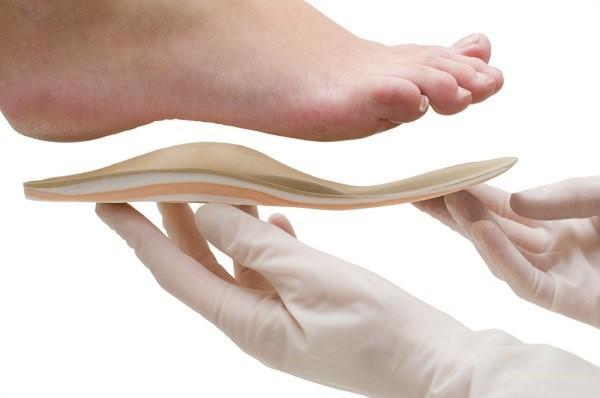
Commonly known as a bunion, the hallux abducto valgus is a inflammation of the bone of the big toe, and can be caused by various factors. It is scientifically recognized that the main contributing factor to bunion development, is the shape of the foot. People with big toes that are longer than the rest of the toes tend to develop bunions. Also, the use of shoes with points or heels and good old genetics, help them develop. Here at oneHOWTO we will explain how to remove a bunion without surgery.
Wear the right shoes
Wondering how to prevent bunions? To start, sufferers of bunions should avoid wearing tight shoes. Instead, they should wear wide shoes that leave room for the feet to move. As a general rule, your big toe should never touch the end of your shoe, leaving room for your big toe to realign. We suggest trying these shoes that will create no further harm to your bunion:
- Ballet flats
- Open sandals
- shoes with wide tips (stilettos are strictly forbidden)
- Flexible footwear

Use a bunion corrector
There are special splints for bunions which can improve the condition. They must be usedconstantly for a period of a few weeks in order tocorrect the bone deformity. The bunion splint will not only help realign your big toe with the rest of your foot, it will also ease the pain. This bunion treatment is for mild to moderate bunions.
Add special insoles to your shoes
You can also consult you podiatrist for the possibility of acquiring some special insoles that aid the realignment of the bones of the feet. Wearing insoles that give you a flat sole will help strengthen your arch instead of acting as a crutch, which will weaken your foot arch muscles. We recommend wearing them for a short while and progressively increase their use.Special insoles should be worn over a period of time to help get rid of bunion foot.

Exercises for bunions
A special rehabilitation exercises specific for bunions can help their correction and improvement. Follow this step by step exercise to improve your bunion and reduce it. To do this, you must work the muscles of your feetin order to soften the foot's tissue, so follow themcarefully.
Massage exercises
- Apply a warming cream to the bunion or hot essential oil.
- Stretch your big toe so that it is realigned with the rest of your foot.
- Holding the toe with one hand, apply pressure with your thumb to the first and second metatarsal bones, in order to find the bunion lump.
- Once you have found the lump, apply gentle pressure downwards (towards the heel) in a straight line. Do not apply too much pressure, as this massage should not hurt. Reduce pressure if you feel pain.
- Once you have done this massage (which will give your toe more flexibility) flex the big toe forward and gently turn the toe. Make sure it is straight and aligned with the rest.
- This will tense the muscles in your toe. With your free hand, apply light pressure to the muscle coming from your big toe towards your foot.
Band stretch exercises
- Get a fairly thick elastic band and put it around both your big toes.
- Stretch your feet outwards slowly, using mild strength in your big toes.
- Hold the position for one minute.
- Release the band and wait for one minute.
- Repeat the process for 15 minutes.
You should do these exercises every day as you take off your shoes.
Ease the pain when possible
If the pain from bunions is very severe, you should opt for one of these bunion pain relief methods. You can take a pain medication such as ibuprofen or paracetamol/acetaminophen. If this is the case, you should consult a specialist.If the bunion is swollen and red, you can apply ice to the painful area to reduce inflammation. Remember to cover the ice with a cloth so that it is not in direct contact with skin. Keep in place for as long as 10 minutes to notice the swelling from your bunion reduce.Always consult your physician before taking any medication regularly.
Use bunion pads
Also, you can purchase pads that will protect the concerned toe with bunions and superior part of the foot base. This will stop the emergence and/or growth of the bunion as well as enhancing mobility and comfort when walking.

Home Remedies for bunions
There are some home remedies that will help relieve the pain of bunions and relax your feet completely. Some of the most effective are the following:
- Apply lavender oil on the bunion and massage the area as shown above every night before going to bed. This oil has excellent anti-inflammatory property.
- Do salt baths. In a bowl with lukewarm water, add two spoonfuls of salt and dab your feet in it for 20 minutes twice or three times a week. Epsom salt is the most recommended for this purpose due to its high magnesium content.
- Apply hot water compresses on the bunion every night.
- Chamomile tea will not reduce your bunion but will at least help relieve the swelling. Just boil some chamomile in water and apply on the bunion with a cotton swab for ten minutes to relieve the area. Repeat the process three times a day until the pain ceases. You can also use chamomile essential oil.
- Learn how to get rid of bunions with bay leaves, which are known to be an effective home remedy.

As your last resort
Always use footwear suitable for the task you are doing and that is comfortable and flexible. For example: sport, walking, for the different seasons, in the countryside, by the sea, etc.If your bunions are severe and accompanied by strong pain, we recommend you see a foot specialist. You may need corrective surgery. In cases where the bunion causes a lot of pain or the deformity is excessive, you should resort to surgery. There are a number of surgical procedures to treat a bunion. Among these are shaping the bony prominence, cutting or improving alignment and removing soft tissue which are compressed to restore joint techniques. The medical specialist will decide what type of operation is best in each case. They will base the decision on the size of the deformation, the patient's age, if they have osteoarthritis in the joint, etcIf you'd like to read similar articles to How to Remove a Bunion without Surgery, we recommend you browse around our Family health category.
This article is merely informative, oneHOWTO does not have the authority to prescribe any medical treatments or create a diagnosis. We invite you to visit your doctor if you have any type of condition or pain.
If you want to read similar articles to How to Remove a Bunion without Surgery, we recommend you visit our Family health category.
- It is recommended you visit a specialist so he or she can inform you what is the stage of development of the bunion.
- Do not self medicate.
- Do not to wear high heel shoes or narrow footwear.
- People who are overweight are more prone to bunions, which is why it's important to keep a healthy weight.